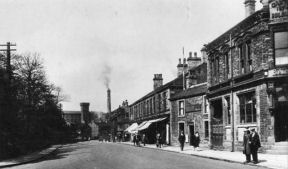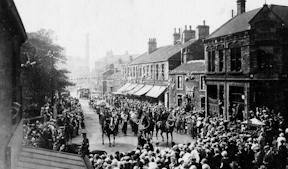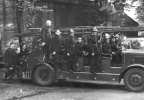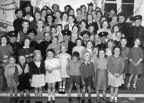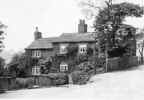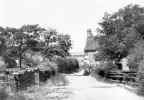The 1940s and earlier
I was baptised at The Parish Church, St. Mary the Virgin, on March 31st 1940 by the Reverend George Roland Hall when I was six weeks old. Later my mother cleaned for the Reverend Hall at the vicarage and also for Miss Stancliffe at the Old Rectory. I remember evacuees staying at the Church House and food parcels from Australia with foods I had never seen before such as tinned peaches. We had a coal burning range, and a tin bath which was filled from a boiler built into the range. I remember my mother black-leading the range and us taking our baths in front of the fire.
The picture below shows the Northorpe Platoon of the Homeguard in Mirfield during World War II.
My father is on the second row back; fifth from the right counting the young chap standing
behind someone's shoulder. Seated at the right-hand end of the front row is my Uncle,
Archie Palmer who was married to my father's sister, Edith. The photograph is presented
here by courtesy of Mrs. L. B. Wolstenholme who's late husband, George, is third from the
right on the back row. The three officers in the centre of the front row are (from the left)
Lt. Bracewell, Capt. Goodall and Capt. Balme. Move your mouse over the picture to zoom in.
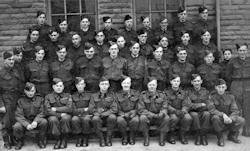
The Homeguard has been the butt of many jokes over the years fuelled by the lightheated view presented by television programmes such as Dads' Army (excellent as this was) but, make no mistake, these men really did represent our last defence against any invading force.
This next group was photographed on land at the bottom of Camm Lane somewhere around 1943 to 1945.
Faces that we know are Rudie and Elizabeth Thramer, Eric, Audrey, Ronald and Brian Ellis, Graham
Peacock, Mary and Colin Parkinson and Miss Stancliffe, who would have been living at the Old Rectory
at this time. Trevor Stewart is on the middle row with the braces (suspenders for our American friends)
next to my brother Ronald, and a young Patrick Stewart, second from the left at the front next to his
childhood friend, Fred Fisher. We can also pick out Mavis and Mary Clegg, Edith and Joan Gomersal,
Dennis Marshall, Mrs Ducker, Betty Cartwright, Brian Sampson, Edna Wilson, Molly Haigh, Dorothy
Fretwell, Terry and Pat Ryan, Cyril Brook, Alf Simpson, Bill Haigh, Terry, Brian and Margaret
Middleton, Mrs Pickup, Mrs Middleton, Charlie Simpson and Percy Spenceley.
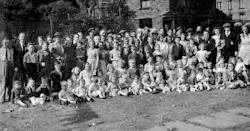
We believe that this may have had something to do with Towngate Working Men's Club which, at that time, was situated just across the road from the site of the photo but don't know what the occassion may have been. If it was as late as 1945 then it may have been a celebration to mark the end of World War II but this is uncertain.
Shown below is a party held by the Battyeford Methodists to celebrate VE Day which was 8th May 1945 and was the end of hostilities in Europe at the close of World War II. The photo is supplied by Rudie and Elizabeth Thramer who are pictured on the middle row, 3rd and 4th from the left just in front of the lady in the pinny.
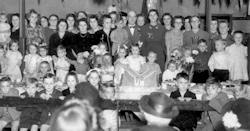
This children's party was held in the chapel at the bottom of Nab Lane for VE Day and was held by the Battyeford Methodists. Note the "V" shaped cake on the table in front of the group.
My father worked on the railway which was a reserved occupation during the war but he served in the Homeguard. His rifle was often hanging behind the front door but I've since learned that it didn't have any bullets. When the air raid siren was heard my mother used to put me and my younger brother Brian under the stone staircase with the tin bath turned upside down over us. My other brother Ronald, my sister Audrey and herself were under the solid table in the room. This was all because she had found earwigs in our Anderson Shelter so would not use it.
Once my older brother put our names forward for the poor children's trip run by the church and my father played merry hell with him saying that we were not poor although in truth we didn't have much of anything even though we always seemed to manage to get by. We didn't get to go on the trip.
I remember the mulberry tree in the grounds of the Old Rectory and a magnificent doll's house in one of the rooms. I remember the old Tithe Barn which stood nearby and garden parties in the grounds of Blake Hall.
Transistors had not been invented then and our valve radio used an HT battery and a Lead-Acid accumulator for the valve heaters, which we had to carry to Herbert Senior's workshop in Littlemoor Road for recharging. Our first mains powered radio was bought from the coop and came as a relief to us children because it didn't need the heavy glass accumulator but instead had a long lead which plugged into an adapter in the light fitting hanging from the ceiling.
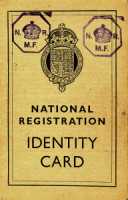
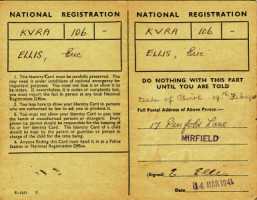
My ID Card - front cover on the left and opened up on the right
We had identity cards then and mine was issued on 14th March 1941 and is shown on the left.
Also all schoolchildren received a proclamation in 1946 from King George VI after the end of World War II. The
proclamation is shown on the right.
Milk was delivered in churns by horse drawn carts from Bob Thwaite's farm at the top of Parker Lane and measured out into a jug using a long handled scoop. One day the horse bolted tipping the cart over and all of Pinfold was awash with milk.
Our next-door neighbours at no. 19 were Mr. and Mrs. Eykyn who had been involved in the theatre in their younger days. Mr. Eykyn first walked onto a professional stage at the age of 10 and maintained a close connection with acting and the theatre until he passed away in October 1956 at the age of 81. He used to make model road rollers from old treacle tins for us. He became involved with the drama productions at the Grammar School taking on the job of making and painting the scenery. He was also the author of over 50 plays.
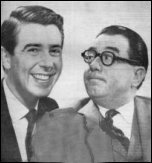
Leslie Crowther & Peter Glaze
Mr. and Mrs. Eykyn had worked for Mr. Will H. Glaze's company at the Alexandra theatre and when, in 1940, they retired to Mirfield they took over the cottage at no. 19 Pinfold Lane that had just been vacated by Peter Glaze's mother who had moved to the cottages at the rear of the Old Rectory. It is only supposition by me that there is a link between Will H. Glaze and Peter Glaze but it does seem a strong possibility. The photo at left shows Peter Glaze with his long time comedy partner Leslie Crowther whose association began with the television programme Crackerjack in 1960. Crackerjack was a children's entertainment show that had its roots firmly set in the old music hall/variety tradition. It was introduced each week with the by-line "It's Friday, it's five to five, and it's Crackerjack!" to which the show's adolescent audience at the BBC's Children's Television Centre would echo the shows title 'CRACKERJACK' at the top of their voice. The show was originally introduced by ex-boxing commentator Eamonn Andrews (later to host This Is Your Life), but perhaps best remembered for its golden era when co-hosts Leslie Crowther and Peter Glaze would perform comedy routines, introduce the guest pop act, and host the weekly quiz 'Double or Drop' that had been devised by Andrews in the early days of the show. In this quiz contestants were given a prize for a correct answer or a cabbage for a wrong one, and then had to hold as many as they could without dropping them. Win or lose everyone went home with a 'Crackerjack Pencil'. Peter Glaze was a frenetic actor on Crackerjack as Leslie Crowther's sidekick and he did a one-man show in Edinburgh years after his heyday. Peter's more serious acting credits include being a Sensorite in the Doctor Who story The Keys of Marinus and in the Big Spender episode of The Sweeney as Joe Spratt. He died in 1983.
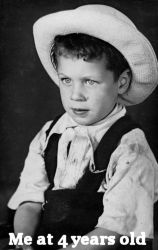
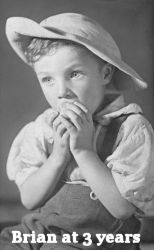
Our next neighbour was William Hepworth, headmaster of the Grammar School, who was also an accomplished amateur photographer and took a prize winning photo of my brother Brian shown on the right. It shows Brian supposedly eating an apple but he was too quick at eating them and several apples were reduced to a core before the picture was ready to be taken. The apple had to be substituted by a sponge ball before the picture could be taken successfully. The photo of myself, on the left, was also taken by Mr. Hepworth.
Mirfield before the 1940s. The larger image has an identification of the main buildings.
A view along Eastthorpe, Mirfield around the 1920s or 1930s and a parade thought to be marking the end of World War One.
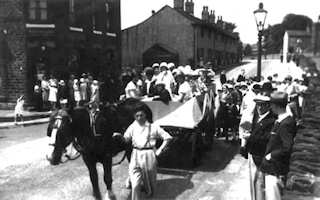
Whitsuntide Walk
Whitsuntide was an important part of our year. That was when the children were kitted out with their new clothes ready for the Whitsunday Walk. As members of the Parish Church we would turn up at Lee Green School, where the Sunday School was held, ready to be organised into a parade and with a lucky coin in one pocket of our new jackets as was the custom of the day. The younger children and the dignitaries would be loaded onto the back of a decorated lorry when I was taking part, but in earlier times it would have been a horse and cart as shown in the picture. The adults and older children walked behind, and out in front was a brass band. The band would start playing and then the procession would move off keeping time with the music. The first stop was just down the road at the Over Hall where a couple of hymns would be sung and then we would move off and along Flash Lane to Northorpe Hall. I can't remember all the places we visited but they included all the main Halls including Blake Hall.
The photograph shows the parade passing along Dunbottle Lane just opposite the top of Camm Lane. The row of houses in the centre background was St. Mary's Terrace and was on the site of what is now the Dusty Miller car park. The houses on the right in the background mark the start of Flash Lane and the soot-stained building at front-left was Maison Sheila's hairdressing shop when I was growing up in this area.
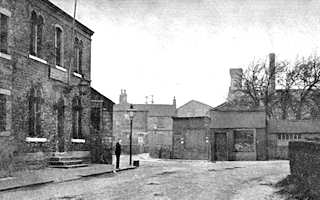
Lower Hopton showing Bridge Hotel
On the left of this photo is the former Bridge Hotel at the Mirfield end of Calder Road, Lower Hopton. The road curving left round the hotel gives access to Butt End Mills, North Street, South Street, etc., and also Lower Hopton School and the engine shed. The road running off to the right crosses Ledgard Bridge on its way to Mirfield town centre and the railway station.
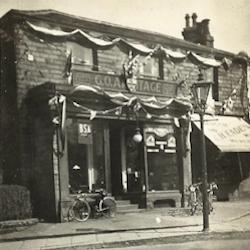
George Oakes Armitage's Cycle Shop
This is the cycle shop at the bottom of Doctor Lane when it was owned by George Oakes Armitage, father of Laurie
Armitage who had the shop when I was a lad. Photo is by courtesy of Joanne and Jason Calvert, George's
great-grandchildren and grandchildren of Laurie. There is also a photo of the shop from Laurie's time on the 1950s
page. Next door can be seen the grocery store of J. H. Eades.
My Junior Years
Crowlees Church of England Boys' School was my Junior School. I moved there from Lee Green Infants School at the age of seven and remained there until 1951 when I was eleven.
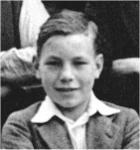
Patrick Stewart aged 10
One of my classmates was to become very famous but we had no inkling of this at the time. This was Patrick Stewart who was to become a world famous actor, equally at home on a Shakespearean stage, on the deck of the USS Enterprise as Captain Jean-Luc Picard or starring in many great films. The photo on the right is of a 10 year old Patrick. It was at Crowlees that I learned to read the old style gas meter with dials, a skill I have never lost. We had a great football team but without any help from me as I was hopeless at all sports. One of the stars of the team was Trevor Brooke who lived at Towngate. His father was a miner in the days before pit head showers and it was a common sight to see him returning home after a hard day in the mines covered in coal dust.
Crowlees Church of England Boys School was my Junior School. I moved there from Lee Green Infants School at the age of seven and remained there until 1951 when I was eleven.
At Crowlees Boys' school, my first teacher was Mr. Townley who pre-dated Mr. Ward. We had to learn to recite our times-tables parrot fashion all the way up to 12 times 12 are 144 and got the ruler across our hands if we got them wrong. If you want to check out the old units of measurement, weight, volume and old money then click the Old Money link at the top of the 'MIRFIELD 1960-92' page.
After the war ended the Air Raid Siren was used to call the volunteer firemen in the event of them being needed to fight a fire; there was also a bell installed in each fireman's home which would rouse them from their beds if they were needed in the night. The siren was tested once a week. At first it was at 10.00 am on Sunday mornings but was later moved to 12.00 noon on Saturdays following complaints from people who wanted to sleep in on Sundays. The fire station was in Ings Grove Park just in from the Huddersfield Road entrance. The red double-doors from which the engines used to emerge have long since been walled up. When the siren sounded the firemen would down tools at whichever local firm they were working and would hurry to the fire station by bicycle or whatever means they had available. The door would open and the fire engine would emerge with its bell ringing and the firemen clinging on sometimes still struggling into their uniforms. The firefighters moved to a new station at the present location on Huddersfield Road (opposite the bottom of Knowl Road) in May 1965.
These 3 photographs were kindly given to me by Marlene Shelton nee Brooke who found my website and thought I might be interested. How right she was. I defy anyone in my age group not to be excited at the sight of our old fire engine parked outside the old fire station in Ings Grove Park. The top photo is from around 1953 and Marlene's father, Gordon Brooke, is sat at the front of the engine in the centre. Other names have recently been offered and are as follows. Sat in the driver's seat is Leonard Beaumont, only one of many Beaumonts who have served with our Fire Brigade over many generations. At the far side of the front seat, wearing a peaked cap, is Station Officer John Twentyman Harrison (Jack). Mr Scargill is seated in the middle row while standing at the back on the lower side-runner, with helmet in hand, is George Garforth. Standing behind the engine at the very back is Jack Thompson.
The middle photo is from about the same time. Kneeling in the centre on the front row is Gordon Brooke and at the right of the photo is another Beaumont, this time George Henry Beaumont who was always know as just Henry. Holding the trophy is Station Officer John Twentyman Harrison (Jack) while at the far right on the back row is Jack Thompson.
The bottom picture is a photo taken at a children's party sponsored by the firemen and dates from 1956. These parties were held in the billiard room above the fire station. Clicking on any of these pictures will show a larger photo. Marlene has supplied the names that she knows and I have had some others supplied too. I list them here but if you can pick out any others then please email me. On the front row, second from the left is Melvin Brooke and on his left (going right) is Marlene Brooke while the front row girl standing in the centre on the step is Christine Thompson. The boy with the zipped cardigan at centre front is Michael Beaumont who was to follow his family's tradition and later become a fireman himself. Second row, second from the right is Michael Brooke and third from the right is Jacqueline Thompson. Third row back and first girl in from the right is Carol Brearley. At the right of the photo at the back and just in front of the window is firefighter Henry Beaumont with his hat pushed back on his head. Moving left we come to Henry's wife, Mavis, holding their baby Keith. Moving on to the centre of the same row is another youngster being held up, wearing a light coloured top, who is Alan Beaumont.
Additional names by Dorothy Fox (nee Holdroyd):
First on the left of the front row is Malcolm Holdroyd; the fireman sat behind him is Stanley Holdroyd with his daughter Dorothy on his knee. Right at the back, to the right of centre, is Mrs Ada Holdroyd holding her youngest son Gerald.
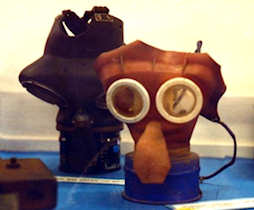
Two gas masks from WWII
The Library had been in Ings Grove Park since 1926 and was housed in one room of the old Ings Grove House that was demolished to build Ings Grove Home for the Elderly, which in turn was demolished to make way for the present building. After the library moved in 1948, part of the building was used as a school clinic and I was sent there to have a verruca cut out when I was about 12. The building that now houses the Library was Eastthorpe Lodge and was built in 1819 by local maltster, John Crowther. It was purchased by the local authority in 1947 and was altered to serve as the library which opened on 3 November 1948. I have a memory of returning our gasmasks there some time after World War II had ended and probably before the library opened. My younger brother and myself had Donald Duck gasmasks and we used to play games in them but fortunately never needed to use them for the purpose they were intended.
The top photo on the left is how it looked at the top of Pinfold Lane at the time when I lived in the house at the bottom of the hill. These cottages were pulled down when the whole area was developed in the 1960s.
When we moved onto Kitson Hill Road in 1948 only the houses on the Road itself had been completed and the rest of the estate was one big building site. London Park Estate was only a planner's dream and Fox Royd was still an area of fields. The farm shown in the bottom photo was still occupied but I don't think that any farming was being done.
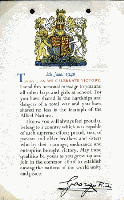
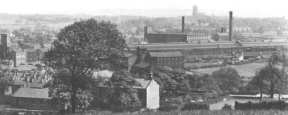 click for larger image
click for larger image